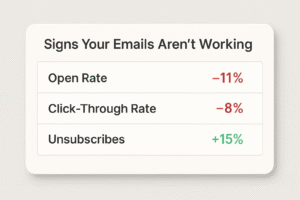🧠 Proven Strategy
The 15-Minute Rule That Converts More Leads
With one of our franchise clients, we installed a system that replies to every inquiry within 15 minutes—even after hours.
Within 30 days:
✔️ Lead-to-close rate jumped 47%
✔️ Review volume doubled
✔️ Weekend inquiries (previously ignored) turned into booked calls
Speed isn’t just polite—it’s profitable.
Use this rule: If you don’t respond in 15 minutes, assume you’ve lost the lead.
What to do:
→ Set up an AI web chat + SMS responder
→ Add a lead assignment system with clear internal rules
→ Track average response time weekly
🛠️ Battle-Tested Tactic
Use This Subject Line to Rescue Your Stalled List
Subject: Still interested, or should I close your file?
This “breakup” email gets 2x higher reply rates than typical follow-ups.
It works because it flips the power dynamic—and prompts a quick yes/no. Great for reviving cold prospects or old lead lists.
🤖 Swipeable Prompt of the Week
Turn Website Visitors Into Buyers with This ChatGPT Prompt
Paste this into ChatGPT:
“You are a conversion copywriter. Rewrite the home page headline for a business that offers [insert what you do] to [insert who you serve]. It should be under 12 words, emotionally compelling, and make the reader want to scroll.”
Use it for testing hooks or improving underperforming landing pages fast.
📈 Campaign Insight
Where Google Ads Actually Work Right Now
Across home services, health clinics, and real estate, we’re seeing this pattern:
🔥 Highest ROI = Google Performance Max + call extension
🧊 Lowest ROI = broad display ads with no conversion tracking
If you’re spending without a conversion goal (form fill, call, appointment), you’re burning cash.
🎙️ Sharp Operator
Quote of the Week — Taylor Welch
“Traffic isn’t the issue.
Conversion is the issue.
You don’t need more eyeballs. You need more yeses.”
Bookmark that.
📢 Real Talk
If your marketing feels chaotic… it probably is.
It’s not that your team isn’t working hard.
It’s that everyone’s reacting instead of executing a system.
Start here:
→ One lead pipeline
→ One message map
→ One source of truth for metrics
Simplify. Then scale.
🔍 What’s New on The Blog
✔️ Signs Your Email Marketing Strategy Needs a Fresh Approach
✔️ How To Handle Negative Comments on Social Media
✔️ Summer Marketing Ideas for Newfoundland Tourism Businesses
Want a free Marketing Health Check?
I’ll show you exactly where leads are leaking—and how to fix it fast.
👉 Start Here
Until next week—stay sharp, execute smarter.
– Bill
Your email list doesn’t mean much if your messages aren’t getting opened, read, or clicked. Marketing strategies should evolve right along with your audience, especially when habits, interests, and expectations shift. What might have worked a year ago can now come across as stale or out of sync. That doesn’t mean you need to start from scratch, but it could be time to rethink how your emails connect with people.
Emails are a chance to speak directly to someone one on one. When they feel like just another generic message, people lose interest fast. If you’re noticing less action on your campaigns, you’re not alone. Many businesses eventually hit a point where their email strategy needs reworking. Spotting the signs early can help you course correct before engagement drops too low.
Indicators Your Email Campaigns Are Underperforming
If you’ve been sending emails regularly but seeing fewer results, the problem may be with how your audience is responding or not responding at all. Campaign performance can slip for different reasons, but there are usually a few common warning signs that signal something’s off.
Here are some to watch for:
– Low open rates: This tells you the subject lines aren’t speaking to your audience or your messages aren’t even making it to inboxes. A drop in open rates is often one of the first red flags.
– Click-through rates falling: People may be opening the email, but if they’re not clicking the links, it likely means your content isn’t convincing enough or your call-to-action feels buried.
– Unsubscribes increasing: This could be a sign people don’t find your content helpful anymore or that they’re receiving too many messages. While it’s normal to lose a few subscribers here and there, spikes should be taken seriously.

These kinds of patterns can sneak up if you’re not actively checking your analytics. For example, a small business owner in Newfoundland might notice their summer promo emails aren’t getting much traction, even though last year’s were a hit. If nothing has changed in the tone or timing, it could mean the audience has shifted or just that the same formula no longer works.
The good news is, once you identify these signals, you’re already one step closer to solving the problem. It’s less about placing blame and more about finding out where tweaks can make a big difference. If one area is consistently falling flat, it’s often a sign you need to update your approach across the board.
Signs Of Content Stagnation
When people feel like they’ve seen your messages before, they start tuning out. Even if your offers are strong, recycled or outdated content can wear thin fast. If your email format hasn’t changed in a while and your wording sounds too familiar, that’s a signal things could use a refresh.
Sometimes it’s easy to fall back on what worked in the past. Maybe you’ve been relying on the same template design for a couple of years. Or maybe your emails follow the same formula every time intro, offer, link, sign-off. That kind of repetition becomes easy to skim and forget. People stop engaging not because your brand isn’t good, but because the content feels a bit too predictable.
There’s also the risk of losing relevance. If your readers are getting messages that don’t match their current needs, they won’t stick around. Real connection comes from showing that you’re still listening to what matters to them today, not what mattered last season.
Personalization is another obstacle. Emails that feel like they were made for everyone tend to click with no one. Using someone’s first name in the greeting isn’t enough. Personalisation should go deeper based on interests, behaviours, or what stage they’re at. Skipping this step makes your messages feel generic, even when your intentions are good.
Design can be a silent deal breaker, too. Older email templates sometimes don’t display well across devices, making it hard to read or navigate. If your visuals aren’t holding up anymore or aren’t mobile-friendly, it might be time for an update.
Behavioural Changes In Your Audience
Now and then, your audience just stops acting the way they used to. These changes can sneak up if you’re not looking at the right things, but they often point to problems with your email approach. What matters is what your audience does after opening your message. If they’re getting less curious about your content or skipping over it altogether, that’s your cue that something deeper is going on.
Pay attention to things like:
– A steady drop in time spent reading your emails
– Fewer replies or follow-ups, especially on emails that used to get strong responses
– Calls-to-action being ignored completely
In some cases, you may notice your emails getting caught in spam filters even when you’re sending them to people who signed up willingly. That can happen when your emails start to look formulaic or flag automated spam indicators. Too many images, the wrong keywords, or even sending at odd times can cause deliverability problems.
Let’s say you’ve been reaching out to your list every two weeks, like clockwork. But over time, the number of people clicking your links or responding keeps shrinking. At that point, it doesn’t matter how often you’re sending they’re tuning out. You could run a re-engagement campaign to try and win them back, but it won’t work if you don’t switch up your style too.
Spotting these shifts puts you in a strong place. Changing how you structure your messages, when you send them, and what content you include can help reconnect with your audience before they disappear for good.
Strategies For A Fresh Start
Once you’ve spotted the weak spots, the next step is about figuring out what changes will actually move the needle. You don’t need to sweep everything away and start over. Small adjustments to how you craft and structure your emails can have a real impact when done with the audience in mind.
Here are a few ways to give your strategy a lift:
1. Run A/B tests
Choose one element to test at a time subject line, imagery, layout, or call to action. This is one of the simplest ways to understand what your audience connects with most.
2. Switch up your content format
Try a fresh tone or structure. Maybe a Q&A style format. Or even a short story highlighting a challenge and how it was solved. Shake off the dull and explore ways to keep things human and useful.
3. Use AI to guide timing and content
AI-driven tools can help figure out when your audience is most likely to open and click and what kind of topics catch their eye. With those insights, you can build campaigns that feel more timely and tailor-made.
Refreshing your visuals can also count for a lot. New banners, simpler calls-to-action, and clearer hierarchy in your email design help your message land better. Don’t forget mobile users when testing design tweaks.
Finding your new direction starts with being honest about what’s working and what’s not. If part of your current process feels like ticking a box, chances are your audience feels that too.
Revitalize Your Email Marketing with BrandCommand
Keeping your emails useful and engaging takes effort, but it pays off in stronger long-term connections with your audience. Stale content and slipping engagement don’t solve themselves, and waiting too long can cost more than just attention it chips away at trust. Whether the problem is your tone, timing, or look, giving your email strategy an honest refresh can bring it back to life.
Getting results again takes more than guesswork. If you’re noticing changes in your audience’s behaviour or you’re feeling stuck in old patterns, it’s a good time to bring in new ideas and structure. With the right approach, you can keep your emails effective, timely, and welcomed in your readers’ inboxes exactly where you want to be. Marketing in Newfoundland has its unique audience expectations, and this is where BrandCommand steps in. Our team knows how to breathe new life into tired campaigns while helping you adapt to new trends without losing your brand voice.
If you’re finding it challenging to keep up with effective email tactics, you’re not alone. If you’re looking to strengthen your approach to marketing in Newfoundland, BrandCommand can help you reconnect with your audience in a meaningful way. Our team offers smart, simple strategies that improve engagement and make your emails feel fresh again. Let’s work together to turn things around and keep your messages landing right where they should—in the inbox, not the trash.
-Bill
You’ve put time and effort into your website. You chose colours that match your brand, added professional photos, and included all the details someone might need to get in touch or learn more. But still, visitors bounce away within seconds. It’s frustrating, and it can feel like a personal loss, but it’s more common than you think.
These quick exits usually have clear, fixable reasons behind them. The good news is, most of these can be solved with smart changes and support from media marketing services. From load speed to layout, small improvements can make a big impact on how long someone sticks around.
Poor Website Design or Layout
Website visitors don’t give second chances. They’ll decide whether to stay or leave within a few seconds of landing on your site. That first impression is shaped by design, layout, and functionality. If your homepage is cluttered, hard to navigate, or looks outdated, it sends the message that your business isn’t professional or trustworthy.
Too many visual elements, unclear navigation, or overlapping text can be confusing. People don’t want to dig around to find what they came for. And if your website takes too long to load, most won’t wait. They’ll click away and move on to the next option.
Try these layout fixes to help keep visitors:
– Keep your layout simple and consistent with a clear path for navigation.
– Use white space strategically so your content feels easy to absorb.
– Stick to two or three main colours and avoid using too many fonts.
– Place your most important information where it’s easy to find.
– Optimise your images to load faster by reducing file sizes.
Media marketing services can redesign or refine your current layout based on what visual styles and structures work best in your industry. With experience in turning cluttered websites into sleek customer experiences, they know how to make your design help rather than hurt your goals.
Irrelevant or Low-Quality Content
Even if your layout is clean, visitors won’t stay if your content doesn’t speak to them. The words on your site should clearly show that you understand what your audience is looking for and how you can help. If your content is outdated, too technical, or feels like filler, you lose credibility quickly.
Your content should give people answers, reassurance, or useful detail. Instead of broad or vague statements, focus on what people genuinely want to know.
Here are some quick ways to improve your site’s content:
– Use clear headings that match what people are searching for.
– Get to the point quickly, especially on your homepage and service pages.
– Include short paragraphs and break up text with bullet points.
– Avoid jargon or insider terms unless your audience expects them.
– Make each page focus on one key topic, problem, or solution.
With ongoing support from media marketing services, you can develop a plan for writing or refreshing your website content on a regular basis. Keeping things readable, relevant, and current sends the right message and can help you stand out from competitors.
Lack of Mobile Optimization
Most people these days browse websites on their phones. If your website only looks good on a desktop, you’re missing out on a huge part of your audience. A mobile site that’s hard to read, too zoomed out, or filled with buttons that don’t work will send people packing.
Even small annoyances add up. Maybe a form won’t load properly or scrolling across the page feels clunky. That kind of experience reflects directly on how people see your business.
To improve mobile usability:
– Choose a responsive design that adapts to different screen sizes.
– Keep fonts and buttons large enough to read and tap easily.
– Put key information higher up on the page so users don’t have to scroll too far.
– Test your layout on both phones and tablets to spot any display issues.
– Consider mobile-specific layout adjustments to prioritise loading speed.
Media marketing services can help identify which parts of your mobile experience create friction. Whether it’s redesigning mobile menus or fixing problems users have reported, expert guidance makes it easier to deliver a friction-free mobile visit.
Annoying Pop-ups and Ads
Pop-ups and ads can help with things like newsletter signups or promotions, but when used incorrectly, they can frustrate people enough to leave. No one likes being interrupted the second they open a page. Worse yet, some designs make it hard to close the window or avoid it entirely.
It’s even more annoying if pop-ups feel repetitive or too aggressive. If someone’s already trying to read about your services or learn more about your products, you don’t want to scare them off before they make it to the right section.
Here’s how to keep pop-ups from derailing the experience:
– Delay pop-ups slightly so they don’t appear the moment someone arrives.
– Allow visitors to close them easily, without digging for a tiny X.
– Use them sparingly—one pop-up is enough at a time.
– Never autoplay sounds or use distracting animations.
– Only use exit pop-ups when visitors move toward closing the page.
With help from media marketing services, you can find a balance between promoting offers and preserving a good user experience. They can set up smart rules based on behaviour and timing so your site doesn’t feel like a sales pitch the entire time.
Making Your Website Visitor-Friendly
Your website should be easy to explore, read, and act on. Visitors need quick access to what matters most—whether that’s booking a service, contacting your business, or finding out how you can help. If too many things are in the way or feel disjointed, it creates a poor impression.
The goal is to respect your visitors’ time. Clean visuals, fast-loading pages, informative content, and working links all play a part. When your site answers questions or solves small pains without effort, people stay longer and trust you more.
To improve visitor-friendliness:
– Check your pages regularly for broken links, old info, or confusing layouts.
– Add user-friendly calls to action that feel helpful, not like pressure.
– Organise your pages so they follow a logical flow that anyone can follow.
– Regularly monitor visitor data to see which pages work and which ones get ignored.
– Collect and act on feedback when users mention things that frustrate them.
Media marketing services can help keep your website up to date, offering suggestions based on user behaviour and experience research. With their support, you’re not guessing what works—you’re making confident decisions backed by data.
Why An Engaging Website Matters
Your website isn’t just a brochure. It’s often the first interaction someone has with your business. When that experience is pleasant, clear, and fast, it encourages people to learn more, take action, and come back later.
Every page should show that you’ve thought about the person reading it. From the way the menu works to the words you use, everything should build trust and reduce confusion. The better your site works, the more likely someone is to become a customer.
Imagine a potential client searching for help and landing on your site. If things load smoothly, content answers their question, and the contact button is right where they expect it, that visit will probably end in a message or booking. When done well, your site becomes the team member that works 24/7 to welcome and guide people in the right direction.
Creating a better experience doesn’t mean redesigning your whole site overnight. It means paying attention to what people need and making thoughtful adjustments along the way. And that’s where BrandCommand comes in.
Enhancing your website’s performance doesn’t have to be overwhelming. If you’re ready to create a site that keeps visitors engaged and converts them into customers, consider exploring how our media marketing services can help with everything from design to content management. Discover what BrandCommand can do to ensure your site captivates its audience.





